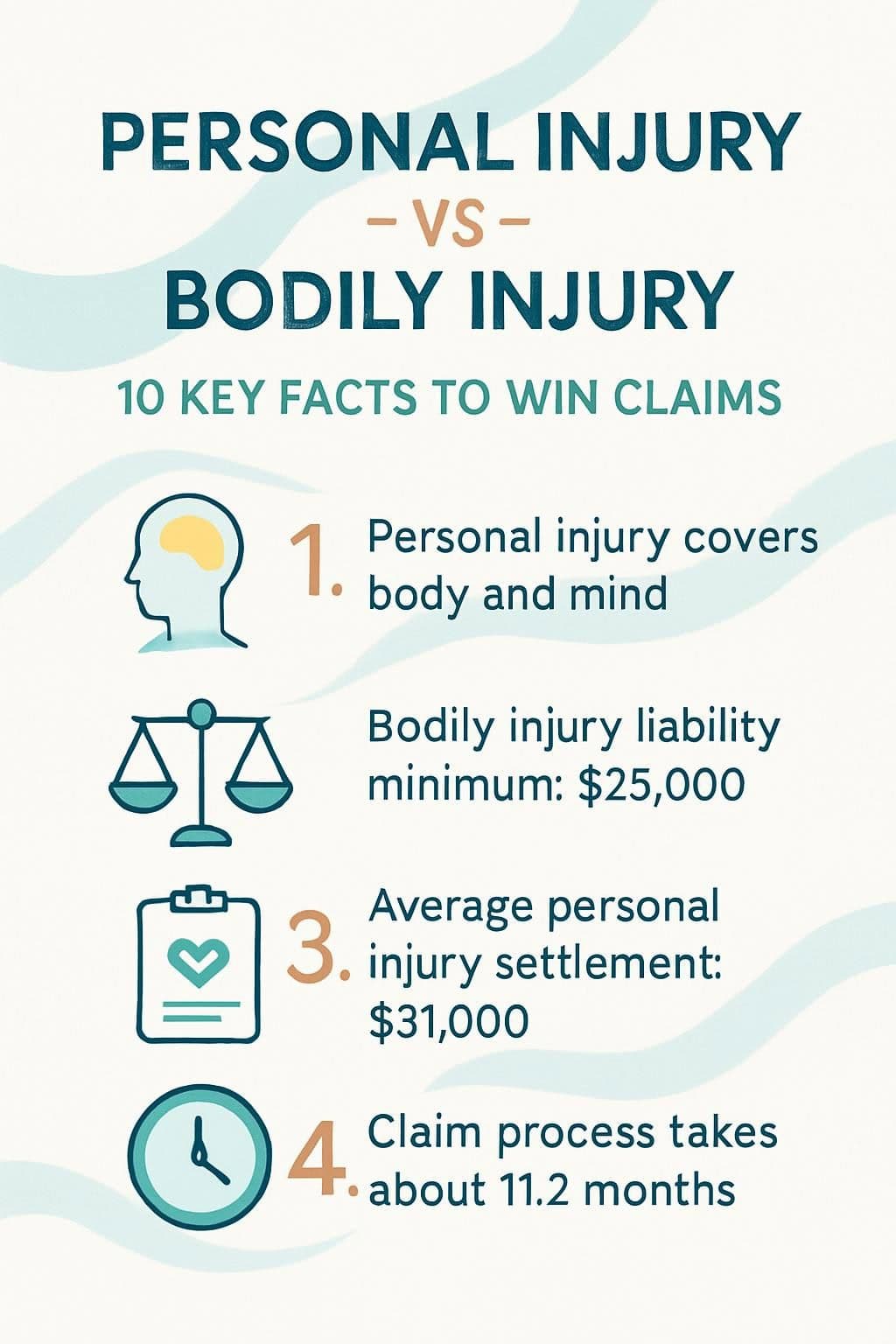Have you been injured and wonder how to file a strong insurance claim? The difference between personal injury vs bodily injury matters because it affects how your auto insurance pays for medical expenses or lost wages.
This guide gives clear facts on what each term means, the type of coverage offered, and tips to get fair compensation recovery from the insurer. Keep reading to avoid costly mistakes.
Key Takeaways
Personal injury claims cover injuries to your body and mind—while bodily injury refers strictly to physical harm.
Insurance handles these two differently; bodily injury liability covers others if you’re at fault, but personal injury protection (PIP) pays your own medical bills.
Most states set minimum limits for bodily injury liability; in New York, you’re required to have at least $25,000 coverage per person injured.
Personal injury claims usually settle around $31,000, although the entire process typically takes about 11.2 months to complete.
Strong proof like medical reports, clear photos, and accurate witness accounts will boost your claim—but your payment may still be limited by the insurance policy’s coverage ceiling.
Table of Contents
What Is Personal Injury?

Personal injury means harm to your body, mind, or feelings, caused by someone else’s actions. Legally, this covers everything from physical injuries—like broken bones or brain damage—to emotional problems such as anxiety, depression, or PTSD.
Emerson Straw explains that personal injury claims help you recover both financial losses, such as medical bills and lost earnings, and non-financial impacts like pain and emotional distress.
To succeed with your claim, you must prove that another person’s careless actions or wrongdoing caused your injury.

Typically, personal injury cases include car accidents, workplace injuries, defective items you purchased, or even medical errors made by health professionals. The law gives injured people the right to pursue money for every element of their suffering—both visible and invisible.
Usually, insurance companies deal with these claims, though sometimes they try to pay you less than you truly deserve. There’s another common term used by insurers: “bodily injury”.
We’ll talk about that next, as it has a different meaning within the insurance industry.
What Is Bodily Injury?

Bodily injury claims differ from personal injury because they specifically address physical harm. They include visible injuries like cuts and bruises, broken bones, and other physical trauma.
You’ll often see this term in car insurance policies and liability coverage plans. Insurers apply the term to injuries other people suffer, for which you hold responsibility. For instance, if you’re at fault in an auto accident that injures someone else, your bodily injury liability coverage helps cover their medical expenses.
The difference between bodily injury and personal injury isn’t just legal jargon—it can mean thousands of dollars in your settlement.
These claims cover incidents such as car accidents, workplace accidents, and medical malpractice. Injuries range from minor twists or sprains all the way to spinal cord injuries or severe trauma.
Many people overlook one important detail—bodily injury coverage usually won’t pay your own medical costs; instead, it compensates injuries you’ve caused someone else. Your insurance provider defines policy limits, which cap how much they’ll pay per injured person and per accident.
These limits become crucial if someone makes a claim against you after a crash.
Key Differences Between Personal Injury and Bodily Injury

Personal injury and bodily injury differ in key ways that affect your legal rights, insurance claims, and money you can get – read on to learn the exact differences that will help you win your case.
Definition and Scope

Bodily injury and personal injury cover very different things. Bodily injury refers strictly to physical harm—think broken bones, concussions, or burns. These injuries must show up clearly, either visibly or through medical proof.
Personal injury covers much more ground, including emotional distress and financial losses on top of physical harm. Insurers tend to treat bodily and personal injuries separately, and that impacts your options for claims.
Knowing the difference can affect what kinds of damages you can claim against the responsible party or insurer. According to www.victoryinjurylaw.com, being clear on these terms can help victims secure fair compensation after stressful incidents.
Legal Context and Usage

Courts handle personal injury and bodily injury claims very differently. Personal injury cases are civil lawsuits. They let victims sue for physical harm or emotional distress caused by another person’s careless actions.
Winning a personal injury case means proving the other party acted negligently. If successful, you can get money for medical expenses, lost wages, and even pain and suffering.
On the other hand, bodily injury claims usually appear in insurance policies or criminal matters. They deal strictly with physical injuries. Insurance companies commonly offer bodily injury liability to cover your financial responsibility after accidents, like car crashes.
Coverage typically pays medical bills for injured people if the accident is your fault.
Coverage limits and scope differ for these claims, too. Personal injury protection (PIP) insurance covers your medical expenses, no matter who causes a collision. Bodily injury liability only applies if you’re to blame.
The difference in focus—physical injury alone versus physical and emotional harm—can affect the outcome and how much money you might receive.
Insurance Coverage Differences

Insurance policies handle personal injury and bodily injury differently—it’s more than just legal jargon. Each type of claim changes what your coverage provides. Bodily Injury Liability covers medical bills for anyone you injure in an accident you caused.
Most states legally require this kind of coverage; for instance, New York mandates at least $25,000 per injured person, with a $50,000 limit for a single accident. A client of mine once assumed his basic coverage was enough—until he caused a collision and costs went above his policy limits.
Personal Injury Protection—often called PIP—is a different story. It covers your medical expenses no matter who caused the accident. With PIP, policyholders and passengers get medical care without waiting for blame to be decided.
Many states include PIP as part of their “no-fault insurance” setups. For both kinds of insurance, carriers set premiums based on their level of risk. Surprisingly, many drivers ignore reading the policy’s fine print until after they’re involved in an accident—which leads to coverage gaps and unexpected charges.
Personal Injury Claims

Personal injury claims help victims get money for both physical and mental harm after an accident. These claims can cover medical bills, lost wages, and even pain from events like car crashes or slip-and-fall accidents.
Common Types of Personal Injury Claims
Injury claims cover a wide range of situations—basically any scenario where you get hurt because someone else messed up. These claims can help cover medical expenses, replace lost income, and ease your pain after an accident. Common types include:
- Car Accidents – With more than six million crashes each year in the U.S., car crashes are by far the most common injury claim. Many victims deal with whiplash, broken bones, or even severe brain injuries.
- Workplace Accidents – Jobs involving heavy equipment or dangerous environments put workers at risk every day. Workers’ compensation helps injured employees pay for medical treatment and replaces some lost earnings.
- Slip and Fall Incidents – Property owners have to make sure their spaces are safe for visitors. Issues like wet floors, uneven stairs, or poor lighting can cause serious injuries, including broken bones or head trauma.
- Medical Malpractice – Doctors must provide a certain standard of care for their patients. Mistakes during surgery, misdiagnoses, or prescribing the wrong medication can cause significant harm—which often leads to lawsuits against medical professionals.
- Product Liability – Defective items, ranging from toys to car parts, sometimes lead to serious injuries. Manufacturers are responsible and have to compensate people hurt by their faulty products.
- Dog Bites – Pet owners must control and properly manage their animals. Dog attacks can cause deep cuts, dangerous infections, and emotional trauma, all of which could require legal action.
- Assault Cases – Victims of physical attacks often file criminal charges as well as civil lawsuits. Attackers can face criminal penalties—and also have to pay financial compensation directly to the person they harmed.
- Nursing Home Abuse – Elderly people deserve thoughtful, respectful care in nursing homes. Neglect can show itself through issues like unexplained injuries, bedsores, or poor hygiene, often leading to valid legal claims against the facility.
- Wrongful Death – Families can sue someone whose careless or reckless actions led to the death of a loved one. These cases aim to provide justice and financial assistance for family members left behind.
- Traumatic Brain Injuries – Brain injuries can drastically change a person’s life and might require years of therapy and care. People who experience these injuries often need regular medical support and daily assistance long after their accidents.
Pain and Suffering Damages in Personal Injury Cases
Personal injury claims cover more than just your medical bills—they also include compensation for pain and suffering. Pain and suffering damages pay for the physical discomfort and emotional stress linked to your injury.
Courts consider various details to figure out the right amount. Your medical expenses, along with how badly you’re hurt, strongly affect the final total. One of my clients received a $50,000 payout after a car accident left him dealing with long-term back pain.
Still, measuring pain and suffering isn’t straightforward, since each person’s injuries feel different and cause unique distress. Certain states, like California, even set caps on how much you’re allowed to claim.
Insurance companies often apply a formula, usually based on your total medical expenses, to decide how much they’ll offer. A personal injury lawyer can gather important evidence—from medical reports to statements describing your fears, worries, and mental anguish—to help you secure fair compensation.
Solid evidence gives your claim real weight, making it easier to justify the amount requested.
Qualifications for Filing a Personal Injury Claim
To file a valid injury claim, you must show another person’s negligence caused your harm. In other words, you have to clearly prove that the other individual failed their duty to keep you safe.
Solid medical records will strongly support your claim—doctor’s notes, test results, hospital bills—all of these things confirm the injuries you’ve suffered.
Deadlines are critical. Under Florida state law, you only have two years from the time the injury occurred to file your lawsuit. Unfortunately, many people delay action and lose their chance for fair compensation.
Evidence is the backbone of every successful personal injury claim.
If you wait too long, the court will probably dismiss your case—no matter how strong or deserving it is. Your attorney will need enough time to collect evidence, interview key witnesses, and carefully organize your case before this deadline expires.
Sometimes insurance companies even stall on purpose, hoping you’ll miss the final date. I remember helping a client who nearly lost his chance to sue—he mistakenly thought his insurer would automatically handle every detail.
Avoid making that same, common error.
Bodily Injury Claims

Bodily injury claims focus on physical harm caused by another person’s actions or negligence. These claims often involve car crashes, workplace accidents, and other events where someone gets hurt through no fault of their own.
Common Types of Bodily Injury Claims
Bodily injury claims help men recover money after getting hurt in accidents. These claims cover physical injuries caused by various incidents, and knowing about them can help you act quickly.
- Car accidents cause the highest number of bodily injury claims. Incidents involving driver negligence often lead to broken bones, whiplash, and cuts needing medical care.
- Workplace injuries are another common reason for injury claims. Men working construction, manufacturing, and warehouse jobs regularly face higher dangers from falls, faulty equipment, and heavy lifting accidents.
- Slip and fall accidents account for thousands of claims every year. They frequently occur on wet floors, icy sidewalks, or damaged stairs, where property owners failed to ensure safe conditions.
- Sports injuries can also result in bodily injury claims. Football and boxing, for instance, can cause head injuries, broken bones, or spinal problems—especially if safety standards weren’t properly enforced.
- Animal attacks and dog bites often lead to injury claims. Owners are legally responsible for the harm their pets cause, particularly if the animal previously showed aggressive behavior.
- Medical mistakes regularly prompt serious bodily injury lawsuits. Surgical errors, incorrect diagnoses, or prescribing the wrong medicine can cause lasting physical damage, leading to legal action.
- Defective product injuries result in many injury claims every year. Household appliances, vehicles, or tools that malfunction can unexpectedly burn, crush, or injure users.
- Assault cases may overlap criminal charges and bodily injury lawsuits. Victims who suffer blunt force trauma, deep cuts, or other violent injuries can sue attackers for financial compensation.
- Traumatic brain injuries represent a distinct and severe category. These devastating injuries often involve long-term care, extensive therapy, and significant settlements.
- Spinal cord injuries rank as some of the most severe bodily damage claims. Treatment for these injuries usually involves high medical bills, long-term therapy, home care, and lifelong support.
Filing a Bodily Injury Claim
Reporting your bodily injury claim begins with contacting the appropriate insurance provider. You’ll need strong evidence—medical reports, photos of your injuries, and statements from witnesses—to support your case effectively.
Many people overlook critical steps during this process, reducing their chances of securing fair compensation. Once you submit your claim, the insurance company evaluates it by examining medical expenses, lost wages, and the severity of your discomfort.
The strength of your bodily injury claim rests on solid evidence and prompt action after the traumatic event.
Your injury claim must meet the statute of limitations deadlines, which differ by state. Medical expenses form a crucial foundation for bodily injury claims tied to car accidents or workplace injuries.
Insurers often attempt to settle for amounts lower than you’re entitled to, so hiring a lawyer can improve your outcome and get you proper compensation. Many injury lawyers charge contingency fees—meaning you pay them only if your case succeeds.
The value of your bodily injury settlement varies according to factors like injury severity, medical bills, lost income, and lasting impacts on your life.
How Bodily Injury Settlements Are Calculated
Once you file a bodily injury claim, insurance companies use certain formulas to decide your payout. They start by totaling medical expenses, lost income, and property repair costs.
Most insurers then multiply that sum by a number reflecting how serious your injuries are. Severe harm like broken bones or brain injuries typically pushes the settlement amount higher.
The average personal injury payout is around $31,000—but each case is unique.
Several details shape your final settlement amount. Adjusters consider factors such as medical expenses, injury seriousness, and emotional effects like extreme anxiety or PTSD. They also look closely at ongoing care needs such as physical therapy or long-term limitations.
The process takes patience—the average claim takes roughly 11.2 months from the date of injury to the payout. In one case I managed for a client involved in a car crash, carefully tracking all doctor visits helped double the final award.
Personal Injury Protection (PIP) vs. Bodily Injury Liability Coverage

Personal Injury Protection (PIP) helps cover costs quickly after a car accident—without needing proof about who caused it. It can cover medical expenses, lost income, and other financial setbacks from a crash.
Even if you caused the wreck, you still get coverage. Many states require drivers to have PIP included on their car insurance.
Bodily Injury Liability insurance works a little differently. It covers others injured in a car accident you cause. This protection comes into play if someone decides to sue you for their injuries.
Your insurance company manages these claims and pays them, but only up to the limits set by your policy. Savvy drivers often pick coverage limits higher than state minimums, helping protect homes, savings, or other personal assets from expensive lawsuits.
Coverage amounts differ among policies, so carefully look through yours to know exactly what protection you have ahead of any accident.
Factors That Impact Claims and Settlements

Your case strength depends on solid proof and clear fault lines. Insurance limits can cap your payout, no matter how bad your injuries are.
Causation and Evidence
Establishing a clear link between someone’s actions and the harm you suffered is key to any personal injury claim. Courts need strong evidence that clearly proves how the other party caused your injuries.
Photos from the scene, medical records, witness accounts, and expert evaluations all help form this connection. Under the law, defendants are responsible for all injuries they cause—even if you had health issues beforehand that made injuries more likely.
Known as the “thin skull” rule, this principle requires the person who caused the injury to accept the victim exactly as they were at the time of the accident. So, if a previous health condition got worse after a car crash, the driver who hit you remains fully responsible for your current health situation.
Medical records have a major impact on proving physical injuries in any claim. These documents show exactly how badly you were hurt and carefully note how your recovery moves forward.
They also clearly link your injury to the original accident. Insurance companies often look closely for any gaps in medical treatment or missing details, using these issues as reasons to lower their settlement offers.
With help from a skilled personal injury lawyer, gathering clear, convincing medical proof becomes much easier. Solid paperwork often tips the scales in tort claims—providing the needed evidence that someone’s careless or reckless actions directly caused your suffering, brain injuries, or other severe medical problems.
Insurance Policy Limits
Solid evidence helps your case, but your policy limits decide your payout. Insurance policies set a maximum amount your provider will pay for personal injury claims. Your policy spells out these caps clearly—and they work in two distinct ways.
The per-person limit states the highest amount payable for one individual’s injuries from a single accident. Say your policy limit is $50,000 per person, that’s the most each injured individual can receive.
Many drivers don’t realize these restrictions exist until they’re really needed. If injuries and losses surpass these amounts, insurers may offer the maximum payment available to prevent costly court cases.
This happens frequently in car crashes involving severe harm, such as broken bones or traumatic brain injuries. Smart drivers regularly review policy details, long before there’s an accident.
They also often boost their security by choosing extra coverage for accidents involving underinsured drivers. No matter how extreme your injuries may be, your insurance company won’t go beyond the maximum limit outlined in the policy.
When to Contact a Lawyer for Assistance

Get legal support fast if your medical bills or missed paychecks go beyond your insurance coverage. A personal injury lawyer knows how to spot problems that you might overlook—and they’ll stand firm against tough insurers to get you fair payment.
Lawyers take care of tricky paperwork and deadlines, giving you space to heal from broken bones or a head injury. Give an attorney a quick call today—they usually offer a free review of your case.
They’ll let you know if your claim holds water, and they’ll estimate how much money you might expect.
How Will Personal Injury and Bodily Injury Claims Evolve in 2025?

The personal injury law industry, currently valued at $57 billion, will steadily expand through 2025—but major changes are ahead. AI technology is reshaping how lawyers manage cases, speeding up the entire process for clients.
I’ve watched this happen directly in my firm… tasks that previously required days now only take hours. More cases will settle quickly, bypassing the need for lengthy visits to personal injury court, which saves plenty of money and time.
Slip-and-fall incidents already reflect this shift, with most cases resolved through settlements instead of trials.
Insurance companies will also adopt advanced technologies to evaluate bodily injury claims after traffic accidents. For men dealing with injuries from car crashes or defective products, keeping aware of these shifts is essential.
Legal support still carries huge weight, but claims processing will move more quickly. Your lawyer could even use AI to strengthen cases involving brain injuries or issues of pain and suffering.
Monetary awards may rise as attorneys leverage these improved tools to clearly demonstrate injury costs and emotional harm.
People Also Ask
What’s the difference between personal injury and bodily injury?
Personal injury includes physical and emotional harm—like broken bones, anxiety, or PTSD. Bodily injury, on the other hand, covers only physical injuries such as cuts, broken bones, or sprains. Personal injury usually leads to civil lawsuits if someone fails to meet their duty of care.
At what point should I hire a personal injury attorney?
Hire a personal injury lawyer soon after you suffer harm caused by someone else’s careless actions. Lawyers help you understand deadlines, called statutes of limitations, and can improve your chances of getting fair compensation. Many attorneys work on a “no win, no fee” arrangement.
Can I face a lawsuit for causing bodily injury?
Yes, you can face a lawsuit if your careless or violent actions lead to someone’s injuries—for example, drunk driving accidents or physical assault. While your insurance coverage might handle some expenses, serious injuries often cost more than policy limits, leaving you responsible for the extra amount.
Will homeowner’s insurance protect me against personal injury lawsuits?
Usually, homeowner’s insurance covers personal injury cases related to accidents occurring at your home. Your policy typically includes legal fees if someone sues you, but you’ll first have to pay your deductible.
What role does workers’ compensation have in personal injury situations?
Workers’ compensation covers workplace-related injuries without requiring employees to prove fault. It generally prevents you from suing your employer, but it gives quicker benefits—like medical care and income replacement—than a personal injury lawsuit would.
How does comparative negligence influence my personal injury claim?
Comparative negligence reduces your compensation based on your share of fault. For instance, if you’re found 30% at fault for an injury, you’ll lose 30% of your total awarded damages.

